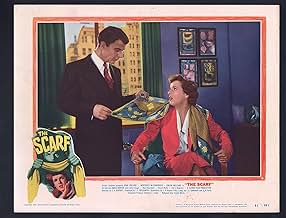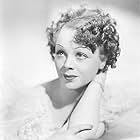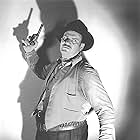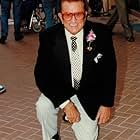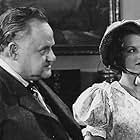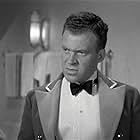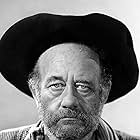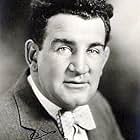A man believed to have murdered a woman, escapes from the insane asylum to find if he was the one who actually killed her using the scarf she was wearing.A man believed to have murdered a woman, escapes from the insane asylum to find if he was the one who actually killed her using the scarf she was wearing.A man believed to have murdered a woman, escapes from the insane asylum to find if he was the one who actually killed her using the scarf she was wearing.
David Bauer
- Level Louie
- (as David Wolfe)
Iris Adrian
- Floozy
- (uncredited)
Richard Alexander
- Barfly
- (uncredited)
Barry Brooks
- Hospital Prison Guard
- (uncredited)
King Donovan
- Piano Player
- (uncredited)
John Frederick
- Deputy
- (uncredited)
Frank Hagney
- Floozy's Boyfriend
- (uncredited)
Frank Jaquet
- Town Sheriff
- (uncredited)
Frank Jenks
- Tom
- (uncredited)
Chubby Johnson
- Feed Store Manager
- (uncredited)
Tom Kennedy
- Asylum Inmate
- (uncredited)
- Director
- Writers
- All cast & crew
- Production, box office & more at IMDbPro
Storyline
Did you know
- TriviaLevel Louie's Bar is apparently in the 500 block of South Main Street, as the Gayety Theatre @ 523 South Main is directly across the street, thanks to a rear projection visible in several shots. The names of Randolph Scott and Don Ameche appear on the marquee; it was the Gayety's policy of listing the players rather than the titles of the films, on their readerboard.
- GoofsWhen Ezra tells the Sheriff and others that his turkeys were disturbed about two hours beforehand, it would be expected that they would investigate to try and find tracks where Barrington had been and to see what direction he had taken away from the farm. Instead they just say good night and leave.
- Quotes
Ezra Thompson: Before a bullet, all men are equal, like in the Constitution.
- ConnectionsReferences The Man Who Came to Dinner (1941)
- SoundtracksSummer Rains
Music and lyrics by Sammy John DeFazio, Charles Milton Daniels (as Charles Milton Daniel) and Gilbert Hugh Hall
Performed by Mercedes McCambridge (uncredited)
[Connie sings the song several times at Level Louie's]
Featured review
I saw this film while catching up on classic film noir. I was not expecting much--a little B film. And Maltin's summary did nothing to encourage my expectations. However, I found a solid film here.
It has an intellectual patina, which is surprising in an American film from 1951. The characters actually talk about some serious issues, though this talk may not be agreeable to some viewers. New York Times critic Bosley Crowther, in his review of this film (April 23, 1951), wrote that the film "expresses in several thousand words of dialogue. . .perhaps the least measure of intelligence or dramatic continuity that you are likely to find in any picture, current or recent, that takes itself seriously." Obviously, I don't agree.
The film is well cast and acted by an unusual combination of actors: John Ireland, Mercedes McCambridge, Emlyn Williams (the English actor), and Ezra Thompson in the leads.
Even the song, "Summer Rains," sung by McCambridge, is perfect for this film: a solid, torchy number in a minor key. Why wasn't this recorded by Peggy Lee or Julie London or Chris Connor? It would have suited them fine.
I was taken totally by surprise by John Ireland's appearance here. This is the only film I've seen Ireland in in which the man is hot, sexy, alluring--certainly not words that one would normally use in discussing John Ireland's appearance. A good part of this is due to cinematographer Franz Planer, though Ireland got some help from his costumes, too. Planer is careful to light Ireland's face in a flattering way, and Ireland just shimmers in the shadow and light of the sharp black and white photography. There is one close-up of Ireland that is stunning--a pure Hollywood glamour shot in the Hurrell tradition: Ireland is sitting at a table in a bar. He has his hat cocked so that it hides one of his eyes and throws half of his face into shadow. He slowly looks up at the camera. This kind of glamour close-up was usually reserved for top female stars in Hollywood's Golden Era, but Planer gave it to Ireland here.
In addition to these shots of Ireland's face, which make him truly handsome, he is wearing throughout most of the film a white t-shirt that makes clear that even at age 37 he still had a nice, in-shape body--nice chest, nice biceps. (Ireland started his career performing as a swimmer in a water carnival.) Later on Ireland is shown wearing a black turtleneck sweater that compliments his chest and a black leather jacket. And who put those pants on Ireland? They aren't expensive--just cheap cloth, but in every scene, those pants just hug the long, lean lines of his butt and his upper thighs. Hot stuff!
I found the film totally absorbing, so much so that I got through the final movie hokum scene which reveals the villain. I can see how some would react negatively to this film. For instance, critic Manny Farber writing in The Nation (May 26, 1951) called "The Scarf" "a disjointed, monstrously affected psycho-mystery freak show." Ha! That comment could be considered a reason to see this film today, Manny.
There is a satisfactory plot summary and commentary on this film on pages 152-3 of Robert Ottoson's The American Film Noir (Metuchen, New Jersey: The Scarecrow Press, 1981). However, Ottoson misidentifies Dr. David Duncan as "the prison psychiatrist." He is, in fact, a psychiatrist in private practice and a friend of Cyrus Barrington. Ottoson says that actor Lloyd Gough plays "the detective." Gough plays Dr. Gordon, who is the prison psychiatrist.
It has an intellectual patina, which is surprising in an American film from 1951. The characters actually talk about some serious issues, though this talk may not be agreeable to some viewers. New York Times critic Bosley Crowther, in his review of this film (April 23, 1951), wrote that the film "expresses in several thousand words of dialogue. . .perhaps the least measure of intelligence or dramatic continuity that you are likely to find in any picture, current or recent, that takes itself seriously." Obviously, I don't agree.
The film is well cast and acted by an unusual combination of actors: John Ireland, Mercedes McCambridge, Emlyn Williams (the English actor), and Ezra Thompson in the leads.
Even the song, "Summer Rains," sung by McCambridge, is perfect for this film: a solid, torchy number in a minor key. Why wasn't this recorded by Peggy Lee or Julie London or Chris Connor? It would have suited them fine.
I was taken totally by surprise by John Ireland's appearance here. This is the only film I've seen Ireland in in which the man is hot, sexy, alluring--certainly not words that one would normally use in discussing John Ireland's appearance. A good part of this is due to cinematographer Franz Planer, though Ireland got some help from his costumes, too. Planer is careful to light Ireland's face in a flattering way, and Ireland just shimmers in the shadow and light of the sharp black and white photography. There is one close-up of Ireland that is stunning--a pure Hollywood glamour shot in the Hurrell tradition: Ireland is sitting at a table in a bar. He has his hat cocked so that it hides one of his eyes and throws half of his face into shadow. He slowly looks up at the camera. This kind of glamour close-up was usually reserved for top female stars in Hollywood's Golden Era, but Planer gave it to Ireland here.
In addition to these shots of Ireland's face, which make him truly handsome, he is wearing throughout most of the film a white t-shirt that makes clear that even at age 37 he still had a nice, in-shape body--nice chest, nice biceps. (Ireland started his career performing as a swimmer in a water carnival.) Later on Ireland is shown wearing a black turtleneck sweater that compliments his chest and a black leather jacket. And who put those pants on Ireland? They aren't expensive--just cheap cloth, but in every scene, those pants just hug the long, lean lines of his butt and his upper thighs. Hot stuff!
I found the film totally absorbing, so much so that I got through the final movie hokum scene which reveals the villain. I can see how some would react negatively to this film. For instance, critic Manny Farber writing in The Nation (May 26, 1951) called "The Scarf" "a disjointed, monstrously affected psycho-mystery freak show." Ha! That comment could be considered a reason to see this film today, Manny.
There is a satisfactory plot summary and commentary on this film on pages 152-3 of Robert Ottoson's The American Film Noir (Metuchen, New Jersey: The Scarecrow Press, 1981). However, Ottoson misidentifies Dr. David Duncan as "the prison psychiatrist." He is, in fact, a psychiatrist in private practice and a friend of Cyrus Barrington. Ottoson says that actor Lloyd Gough plays "the detective." Gough plays Dr. Gordon, who is the prison psychiatrist.
- How long is The Scarf?Powered by Alexa
Details
- Runtime1 hour 33 minutes
- Color
- Aspect ratio
- 1.37 : 1
Contribute to this page
Suggest an edit or add missing content







